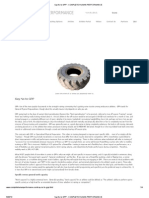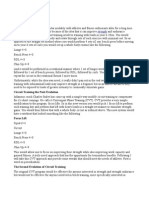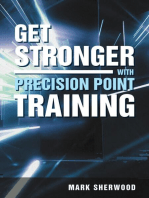Best Supersets by Eric Cressey
Best Supersets by Eric Cressey
Uploaded by
Lewis TohCopyright:
Available Formats
Best Supersets by Eric Cressey
Best Supersets by Eric Cressey
Uploaded by
Lewis TohCopyright
Available Formats
Share this document
Did you find this document useful?
Is this content inappropriate?
Copyright:
Available Formats
Best Supersets by Eric Cressey
Best Supersets by Eric Cressey
Uploaded by
Lewis TohCopyright:
Available Formats
Best Supersets by Eric Cressey
5/26/11 11:14 PM
Published on Enhanced Fitness and Performance (http://www.enhancedfp.com)
Best Supersets by Eric Cressey
By DMorgan Created 11/03/2010 - 12:36pm Guest Article By Eric Cressey Author Show & Go High Performance Muscle System [1] (originally posted on T-NATION.com) Supersets can help you gain more muscle in less time, but only if you know how to pair the perfect exercises. Ive come to realize that over the past ten years, Ive gotten a little spoiled. Of course, there are a variety of reasons: T NATION readers are some of the more educated weight-training consumers on the Net; Ive been around Division 1 athletes who have four years of strength and conditioning continuity in their lives; Ive lifted alongside world-class powerlifters; I have a host of athletes who are completely indoctrinated with my training philosophies, as its the only thing theyve ever known. Yeah, I guess you could say that Ive become a bit of a lifting snob; Im always surrounded by people who know how to interpret my programs, leaving me to just program, coach technique, help select weights, and turn up the volume on the stereo. I realized I was in Fantasyland, though, when my second book, Maximum Strength, was published in June of 2008. This book, which had a bit more mass market flavor than the overwhelming majority of my work, was being sold online and in bookstores from Idaho to Thailand, and many of the people buying it were Average Joes who didnt know how to interpret the programs Id written. One question I received sticks out in my mind: I see the A1 and A2? / B1 and B2? designations, but am not sure I understand if Im supposed to alternate the exercises that day (for example, do a set of one-arm DB push press and then do a set of close-grip chin-up and cycle through to complete 3 sets each) or am I supposed to pick one exercise for week 1 and then choose the other exercise in week 2? The answer, as the overwhelming majority of T NATION readers knows, is that A1 and A2 indicates a superset. You go back and forth between the two (in all weeks), and once youve completed A1 and A2, you move on to B1 and B2, then C1 and C2, and so on. So, you do all the exercises in all the weeks. The idea is pretty simple: youre making your training more efficient. So, rather than doing a set of bench presses and then standing around for two minutes before the next set, you superset the bench presses with a variation of rows or a flexibility exercise, for instance. You increase training density and can use the pairings to bring up weak areas.
http://www.enhancedfp.com/node/1310/print Page 1 of 8
Best Supersets by Eric Cressey
5/26/11 11:14 PM
We know supersets work; in fact, it might be one of the few things that the overwhelming majority of strength coaches and personal trainers agree on! However, a lot of guys make poor choices (yes, even you). For instance, youll often see people pairing walking dumbbell lunges and chin-ups, both of which are pretty grip-intensive. As such, I thought itd be a good time to share some of my favorite supersets so you can use them in your programs immediately.
1. The Regular Ol Push-Pull Superset
This is probably where weve come to recognize the value of supersets more than anywhere else. Do a set of presses, and instead of just waiting 2-3 minutes to go back to another set of presses, we go to a pull in the middle of the rest period. Lets look at what this works out to over the course of five sets, assuming a two-minute rest between sets and a set duration of thirty seconds: Option A Just press n wait 30s set 120s rest 30s set 120s rest 30s set 120s rest 30s set 120s rest 30s set Total Time: 10 minutes, 30 seconds Option B Pairing a press and a pull with a moderate rest between push and pull
http://www.enhancedfp.com/node/1310/print Page 2 of 8
Best Supersets by Eric Cressey
5/26/11 11:14 PM
30s set (press) 60s rest 30s set (pull) 60s rest 30s set (press) 60s rest 30s set (pull) 60s rest 30s set (press) 60s rest 30s set (pull) 60s rest 30s set (press) 60s rest 30s set (pull) 60s rest 30s set (press) 60s rest 30s set (pull) Total Time: 14 minutes Effectively, youve doubled your training density while only investing 33% more time. And, if you cut the rest intervals down to 45s between the end of a press set and the start of the pull set, you actually keep the rest between sets of presses the same as you did in Option 1 and your total time will be down to 11 minutes, 45 seconds. You dont have to be an economistor even a graduate of the 6th gradeto know that this is a wise training investment. More work in less time holds merit in lifting heavy stuff just like it does in the business world. The logical next question is, of course, what kind of pushes and pulls? Its a pretty easy division to make, via four categories: 1. Vertical Push (overhead pressing) 2. Vertical Pull (chin-up/pull-up variations, lat pulldowns) 3. Horizontal Push (bench press and push-up variations) 4. Horizontal (rowing variations) Pair the vertical pushes with the vertical pulls, and horizontal pushes with the horizontal pulls. And, if youre feeling frisky, you can pair horizontal pushes with vertical pulls, or horizontal pulls with
http://www.enhancedfp.com/node/1310/print Page 3 of 8
Best Supersets by Eric Cressey
5/26/11 11:14 PM
vertical pushes. Your imagination is the only limit. A word of advice: youll never get completely perfect antagonist relationships. For example, the long head of the triceps is going to be at least somewhat active in every one of these variations because its both a shoulder extensor (pull-ups and rows) and an elbow extensor (all presses). The long head of the biceps flexes both the shoulder (all presses) and elbow (pull-ups and rows) on top of contributing to shoulder joint stability in all tasks. Your rotator cuff is going crazy in all these movements. In short, consider gross movement schemes and try to avoid blatantly obvious overlap in muscle recruitment. But dont get bogged down in minutia when selecting your pairings.
2. The True Mark of Your Common Sense Superset
A1) Deadlift variation A2) Heavy panting! I throw this in here simply because I want people to realize that not everything in your training needs to be supersetted with another exercise. Sometimes standing aroundor at the very most, doing an unrelated stretch or easy mobilizationis exactly what you want. I once heard about a trainer who supersetted back squats with stiff-leg deadlifts. This less-than-enlightened trainer overlooked the fact that: a) Both exercises heavily tax the posterior chain b) Both movements absolutely destroy you which, you know, just might compromise technique c) Intervertebral discsand not just muscles and the nervous systemare relaxing between sets, too There are, however, a few ways to make the downtime between deadlift sets more productive.
http://www.enhancedfp.com/node/1310/print Page 4 of 8
Best Supersets by Eric Cressey
5/26/11 11:14 PM
3. The Stiff Ankle Superset
A1) Deadlift variation A2) Ankle Mobilization We do all our deadlifting variations without shoes at Cressey Performance, as this allows athletes to keep the weight on the heels to better activate the posterior chain. It also brings the lifter closer to the ground, so hip mobility deficits cant interfere with getting down to the bar without a rounded back. Being shoeless also lends itself well to working on some ankle mobility, as being in sneakers typically gives us a false sense of good range of motion at this joint. Wall ankle mobilizations are one option. Here, the goal is to keep the heel down while going into dorsiflexion (knee over toe); dont allow the knee to deviate inward, though.
4. The Front Squat/Vertical Pull Superset
Its a bit easier to superset squats with other movements than deadlifts, but only in specific cases like this: A1) Front Squat Variation A2) Vertical Pull Variation The lats are anatomically less effective as spinal stabilizers during the front squat, which accounts for some of the discrepancy between ones front squat and back squat. If were not using them as much in stabilization for the front squat, we might as well use them for actually generating movement. For variation, you can squat to various depths, from pins or a box, or against bands/chains. With the vertical pull, you have several grip choices (neutral/supinated/pronated/alternate, plus different grip widths). As you get stronger and stronger, though, pairing anything with a squat can get to be a pain in the butt. With that in mind, one substitute weve used is pairing reverse lunges with a front squat grip
http://www.enhancedfp.com/node/1310/print Page 5 of 8
Best Supersets by Eric Cressey
5/26/11 11:14 PM
with any of the vertical pulling variations, and just extended the rest time a bit. You can also use any lunge variation that uses a bar (dumbbells wont work because of the grip challenge). We use the giant cambered bar a lot.
5. The Unilateral Superset
I get quite a few questions about how to plug single-leg exercises into supersets. A1) Single-leg Exercise side #1 A2) Single-leg Exercise side #2 I structure programs this way because I want people to rest between sides on these movements. Grips falter, scapular stabilizers get fatigued, and theres always a bit of overlap from side to side on these movements. As such, I like to shoot for 30-45 seconds between sides, during which time people can regroup and focus on the quality of the next set instead of rushing right into it. That said, we generally pair our lower-body work with some kind of core stability or mobility drill. So, I guess it would technically be treated like a triset (or quad-set, if one of these drills is performed on each side).
6. The Miserable Lower Body Experience Superset
As I noted above, one of the problems I see with a ton of lower body supersets is that they combine complex exercises like squats and deadlifts with other fatiguing exercises and as a result, the squat and/or deadlift form becomes absolutely atrocious and potentially injurious. From my perspective, effective lower body pairings are safe, but sufficiently compound and functional enough to activate enough muscle mass and have some functional carryover to the real world. I know most of you wont have a sled or a glute-ham raise at your disposal, but Im throwing this out there anyway, as it makes for a great finisher at the end of a lower body day:
http://www.enhancedfp.com/node/1310/print Page 6 of 8
Best Supersets by Eric Cressey
5/26/11 11:14 PM
A1) Reverse Sled Drags A2) Glute-Ham Raises The reverse sled drags are about as quad dominant as you can go, and the glute-ham raises crush the posterior chain. Dont have a sled or glute-ham raise set-up? All youll need are a bench, a lat pulldown or seated calf raise, a pair of balls, and a good stomach. That way you can pair DB Bulgarian split squats with natural glute-ham raises. For the latter, just set up in reverse and lock your ankles under the pads, controlling yourself down slowly and (most likely) giving yourself a push off with your arms to get back to the top.
7. The Tony Gentilcore is a Royal A**hole Superset
Our entire staff trains together at Cressey Performance. Usually, we take one general program and modify it individually to suit our needs. Recently, it was Tony Gentilcores turn to write up the monthly program, and our first superset on a Thursday lift was as follows: A1) Bench Press Clusters: 4 x (42) 10s A2) Farmers Walk: 480yds, going as far as you can on the last set For those of you who arent familiar with clusters, for 4 x (42) 10s, this would be four total clusters. Each cluster consists of 4 sets of 2 reps with 10 seconds rest between sets. The idea is that by putting these mini-rests between sets of 2, you can use a heavier weight for your sets than if youd just done eight straight reps. So, training is more dense. All told, you might wind up doing 32 reps with as much as 85% of your 1-rep max. After the cluster, of course, we went to A2, nearly vomited, and then came back to do another cluster. There was a 25% attrition rate after the second round, and the remaining three of us made it through all four, but couldnt lift our arms for about three days without yelping like a chihuahua giving birth. To the naked eye (and stomach), this would just seem like torture, but whether he recognized it or not, Tony was on to something. Bench presses are a push and require some lower trap activation for a good
http://www.enhancedfp.com/node/1310/print Page 7 of 8
Best Supersets by Eric Cressey
5/26/11 11:14 PM
tucked upper body positioning. Farmers walks are more of a pull and rely heavily on the upper traps. Lower traps depress the scapula, and upper traps elevate it. Smart move. I still hated him for it, though.
Supersetting My Closing Thoughts
A1) Your imagination is the limit to designing your own supersets. Just stick to the basics and dont get cute. A2) Remember that good pairings are both safe and appropriate in light of your goals (e.g., not pairing two grip intensive exercises). B1) Dont forget that there is absolutely a time and place for rest, and its usually better to casually alternate between sets, as opposed to racing back and forth. B2) Just because I am showing you a way to make your training more dense and efficient does not mean that you should go ahead and start doing 50 sets per training session just so that you can continue to spend three hours in the gym. Keep it short and sweet. C1) Good luck. C2) Thanks for reading. Eric Cressey is a highly sought-after strength and conditioning coach and Author Show & Go High Performance Muscle System [2]. Eric has worked with athletes of all levels, from youth sports to the professional and Olympic levels. Source URL: http://www.enhancedfp.com/workout-programs/strength/best-supersets-eric-cressey Links: [1] http://tinyurl.com/2edvyzf [2] http://tinyurl.com/2edvyzf
http://www.enhancedfp.com/node/1310/print
Page 8 of 8
You might also like
- The High Performance Handbook by Eric CresseyDocument75 pagesThe High Performance Handbook by Eric Cresseygabriel93% (40)
- Maximum Strength Eric CresseyDocument232 pagesMaximum Strength Eric CresseyTAURUS1313100% (3)
- The Juggernaut Method 2.0: Strength, Speed, and Power For Every AthleteFrom EverandThe Juggernaut Method 2.0: Strength, Speed, and Power For Every AthleteRating: 4 out of 5 stars4/5 (35)
- Westside For Skinny Bastards by Joe DefrancoDocument22 pagesWestside For Skinny Bastards by Joe DefrancoJason Clusiault100% (15)
- Atls FlashcardDocument74 pagesAtls FlashcardAzis Aai92% (72)
- 1x20 - YessisDocument21 pages1x20 - YessisNoel Martin100% (2)
- FSU ManualDocument137 pagesFSU ManualDarryn FiskeNo ratings yet
- Eric Cressey - FST - Upper Body - ManualDocument52 pagesEric Cressey - FST - Upper Body - ManualKarol Sikora50% (2)
- Off-Season Training For AthletesDocument17 pagesOff-Season Training For AthletesNicholas C. Scott100% (8)
- John Rusin - 28-Days-Later-Bodyweight-x-BandsDocument21 pagesJohn Rusin - 28-Days-Later-Bodyweight-x-BandsCarlos Alberto Acevedo82% (11)
- 1 X 20 METHOD v1.2 PDFDocument10 pages1 X 20 METHOD v1.2 PDFDJ100% (1)
- PARISI SPEED School Warm Up DrillsDocument2 pagesPARISI SPEED School Warm Up Drills44dwymanNo ratings yet
- Boyle TemplateDocument1 pageBoyle TemplateSBD4life100% (1)
- Deload To Reload: and Other StuffDocument18 pagesDeload To Reload: and Other Stuffxceelent86% (7)
- Utilizing Accommodating ResistanceDocument34 pagesUtilizing Accommodating ResistanceZac Brouillette100% (1)
- Five Fantastic FinishersDocument9 pagesFive Fantastic Finishersdiskra100% (3)
- Eric Cressey Corrective TrainingDocument67 pagesEric Cressey Corrective Trainingberthakey840794% (18)
- Eastern Bloc Model of Development in UWW WarhawksDocument40 pagesEastern Bloc Model of Development in UWW WarhawksDJ100% (5)
- 1 X 20 Method Training Program: Training Template by Jake TuuraDocument9 pages1 X 20 Method Training Program: Training Template by Jake TuuraCarlos Alberto Acevedo100% (1)
- Winkelman Nick Learning To Sprint 40th 0Document34 pagesWinkelman Nick Learning To Sprint 40th 0Louit Loïc100% (11)
- Explosive Power and StrengthDocument4 pagesExplosive Power and StrengthChili Baron100% (1)
- Cal Dietz Advance Methods in Triphasic Training FinalDocument42 pagesCal Dietz Advance Methods in Triphasic Training FinalRyan Hicks100% (17)
- Book of Programmes for the Team Sport Athlete; Size & StrengthFrom EverandBook of Programmes for the Team Sport Athlete; Size & StrengthNo ratings yet
- Competitive Advantage Training : 50 Week Hockey Training ManualFrom EverandCompetitive Advantage Training : 50 Week Hockey Training ManualRating: 4.5 out of 5 stars4.5/5 (2)
- Benevolent FundDocument14 pagesBenevolent FundHumayoun Ahmad Farooqi100% (1)
- Cressey Performance Post-Throwing Stretches1Document7 pagesCressey Performance Post-Throwing Stretches1Anonymous PDEpTC4No ratings yet
- Westside For Athletes Eric CresseyDocument32 pagesWestside For Athletes Eric CresseyZac Brouillette100% (12)
- Mobility Warm-UpDocument12 pagesMobility Warm-Uphowdy1010% (1)
- RTS Start Up Mike Robertson Evaluation SheetDocument7 pagesRTS Start Up Mike Robertson Evaluation SheetZachary LeeNo ratings yet
- Brick Training Method PowerpointDocument47 pagesBrick Training Method PowerpointZac Brouillette100% (10)
- Athletic Testing GuideDocument38 pagesAthletic Testing Guidethomaslam1166100% (3)
- Training The Injured Shoulder During and Post Rehab - HandoutsDocument29 pagesTraining The Injured Shoulder During and Post Rehab - HandoutsDADDYGUS100% (3)
- FSC7 Web PDFDocument300 pagesFSC7 Web PDFanon100% (1)
- Microsoft PowerPoint - Joe KennDocument14 pagesMicrosoft PowerPoint - Joe KennTroof10No ratings yet
- Cal Dietz - Advanced Principles in ProgrammingDocument31 pagesCal Dietz - Advanced Principles in Programmingeloganbyman100% (3)
- Chris - Joyner - Presentation Canada 2015 - Baseball Periodization End ExercisesDocument49 pagesChris - Joyner - Presentation Canada 2015 - Baseball Periodization End ExercisesjoaoaesfigueiredoNo ratings yet
- Buddy Morris InterviewDocument27 pagesBuddy Morris Interviewryan9871No ratings yet
- GPP ManualDocument22 pagesGPP Manualdline99100% (5)
- Sport-Specific Speed For Big Men - Improving AccelerationDocument14 pagesSport-Specific Speed For Big Men - Improving AccelerationRayNo ratings yet
- Energy System DevelopmentDocument12 pagesEnergy System DevelopmentSusovan Ghosh100% (5)
- Alex Viada - Say No To GPP - Complete Human PerformanceDocument4 pagesAlex Viada - Say No To GPP - Complete Human Performanceclaymore7072049100% (1)
- BlogDocument6 pagesBlogAlex Vasquez100% (1)
- Sub - Maximal - High - Velocity - Peaking - Method - Revised AfsmDocument48 pagesSub - Maximal - High - Velocity - Peaking - Method - Revised AfsmTj Newsom100% (1)
- SquatStrong: A Revolutionary 6 Week Program to New Prs and Higher PerformanceFrom EverandSquatStrong: A Revolutionary 6 Week Program to New Prs and Higher PerformanceRating: 3 out of 5 stars3/5 (4)
- Kettlebell Training for Athletes: Develop Explosive Power and Strength for Martial Arts, Football, Basketball, and Other Sports, pbFrom EverandKettlebell Training for Athletes: Develop Explosive Power and Strength for Martial Arts, Football, Basketball, and Other Sports, pbNo ratings yet
- Teammates for Life: The Inspiring, True Story of Kenny Arnold and the Hawkeye Basketball FamilyFrom EverandTeammates for Life: The Inspiring, True Story of Kenny Arnold and the Hawkeye Basketball FamilyNo ratings yet
- Summary of Dan John, Pavel Tsatsouline & Dave Draper's Never Let GoFrom EverandSummary of Dan John, Pavel Tsatsouline & Dave Draper's Never Let GoNo ratings yet
- Doug Briggs Strength, Speed, & Agility Book 2016: Get Strong, Get Fast, And Get AgileFrom EverandDoug Briggs Strength, Speed, & Agility Book 2016: Get Strong, Get Fast, And Get AgileNo ratings yet
- Taming the Bent Press: A Guide to the King of Lifts DigitalFrom EverandTaming the Bent Press: A Guide to the King of Lifts DigitalNo ratings yet
- Complete Guide to the Vertical Diet: Build Lean Muscle While Enjoying Your Favorite Foods.From EverandComplete Guide to the Vertical Diet: Build Lean Muscle While Enjoying Your Favorite Foods.No ratings yet
- Spectrafuge 6C (CLSLN-AN-1003DOC REV1)Document12 pagesSpectrafuge 6C (CLSLN-AN-1003DOC REV1)Tan Hung LuuNo ratings yet
- F&B NC 11 CBLM Providing Link Between Kitchen & Service AreasDocument27 pagesF&B NC 11 CBLM Providing Link Between Kitchen & Service AreasCarlos Baul David0% (1)
- Indole Alkaloid: Structural Formula of IndoleDocument9 pagesIndole Alkaloid: Structural Formula of IndoleGheorghe Georq NitescuNo ratings yet
- Nursing Technology: La Union Colleges of Science and Technology, IncDocument2 pagesNursing Technology: La Union Colleges of Science and Technology, IncManny Daniel AbuanNo ratings yet
- Omnikin Lesson 1Document7 pagesOmnikin Lesson 1api-338597576No ratings yet
- Physical Compatibility of Octreotide and Pantoprazole.Document8 pagesPhysical Compatibility of Octreotide and Pantoprazole.Zakaria RasmiNo ratings yet
- Dezurik Awwa Butterfly Valves Baw Technical 43 - 00 - 2 PDFDocument24 pagesDezurik Awwa Butterfly Valves Baw Technical 43 - 00 - 2 PDFANILNo ratings yet
- Yoga Postures PDFDocument13 pagesYoga Postures PDFSubramanian KrishnaamurthyNo ratings yet
- CSM Molly 2020Document10 pagesCSM Molly 2020Bright Kasapo BowaNo ratings yet
- Noodle ProcessingDocument2 pagesNoodle ProcessingReyza PrasetyoNo ratings yet
- Eccentric Exercises For HipDocument2 pagesEccentric Exercises For HipMarceloNo ratings yet
- Application of Exponential FunctionsDocument5 pagesApplication of Exponential FunctionsSnoopy 45No ratings yet
- Lgu-Swm-Scmar January-June 2021: Annex ADocument2 pagesLgu-Swm-Scmar January-June 2021: Annex AOremor RemerbNo ratings yet
- Spark em Eswl enDocument15 pagesSpark em Eswl enSaamyNo ratings yet
- Oxygen Delivery Systems: Presenter: Dr. Rangachetan Moderator: Dr. MaazDocument43 pagesOxygen Delivery Systems: Presenter: Dr. Rangachetan Moderator: Dr. MaazAkash SunjeevanNo ratings yet
- Project Report On e CommerceDocument74 pagesProject Report On e CommerceSom Soumya DasNo ratings yet
- T4 AkuntansiDocument3 pagesT4 AkuntansiYusuf HadiNo ratings yet
- Approved List of Confirmations Withdrawals - Sac Jan 2021Document15 pagesApproved List of Confirmations Withdrawals - Sac Jan 2021nambiarnedumchalNo ratings yet
- Construction Quantity Surveying - A Practical Guide For The Contractor's QS - 23Document1 pageConstruction Quantity Surveying - A Practical Guide For The Contractor's QS - 23scriptscriptneNo ratings yet
- BRUCE ANDERSON, JOHN WILSON, ROBERT AUSTIN, and CALIFORNIA ADVOCATES FOR NURSING HOME REFORM v. DIANA DOOLEY, in her official capacity as Secretary of the CALIFORNIA DEPARTMENT OF HEALTH AND HUMAN SERVICESDocument19 pagesBRUCE ANDERSON, JOHN WILSON, ROBERT AUSTIN, and CALIFORNIA ADVOCATES FOR NURSING HOME REFORM v. DIANA DOOLEY, in her official capacity as Secretary of the CALIFORNIA DEPARTMENT OF HEALTH AND HUMAN SERVICESAlex Kacik100% (1)
- Pengaruh Pendidikan Kesehatan Terhadap Tingkat Pengetahuan Ibu Hamil Tentang Tanda Bahaya Kehamilan Di Puskesmas KarangdoroDocument9 pagesPengaruh Pendidikan Kesehatan Terhadap Tingkat Pengetahuan Ibu Hamil Tentang Tanda Bahaya Kehamilan Di Puskesmas KarangdoroyanieschaNo ratings yet
- Beast Upper Body WorkoutsDocument16 pagesBeast Upper Body WorkoutsTrainer Aong100% (3)
- History Spring08 PDFDocument7 pagesHistory Spring08 PDFSpidermanNo ratings yet
- 2023 KC CatalogueDocument19 pages2023 KC CatalogueNader AlkhateebNo ratings yet
- Scientific IntegrityDocument7 pagesScientific IntegrityRahulprabhakaran Vannostran0% (1)
- LP Tle AprilDocument8 pagesLP Tle AprilHerly MartinezNo ratings yet
- Additional Solutions - Chapter 15Document24 pagesAdditional Solutions - Chapter 15maxima0078No ratings yet
- Hereditary SpherocytosisDocument1 pageHereditary SpherocytosisAdrian CabarleNo ratings yet

























































































